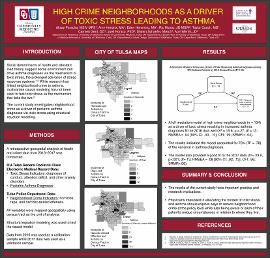| dc.description.abstract | BACKGROUND: Social determinants of health and allostatic load theory suggest social environment can drive asthma diagnoses via the mechanism of toxic stress, the prolonged activation of stress response systems. While research has linked neighborhood crime to asthma, multivariate causal modeling has not been used to test toxic stress as the mechanism that links the two. The current study investigates neighborhood crime as a driver of pediatric asthma diagnoses via toxic stress.
METHODS: A retrospective geospatial analysis of health and crime data was conducted. Health data was collected from the OU-Tulsa General Pediatric Clinic’s Electronic Medical Record while crime data was collected from the Tulsa Police Department. All variables were mapped geospatially using census tract as the unit of analysis. Structural equation modeling was used to test the causal model. Neighborhood crime indicators included homicide, rape, and narcotic-related offenses. Diagnoses of conduct, attention deficit, and other anxiety disorders were used in the analysis as toxic stress indicators. Asthma diagnoses were the outcome variable. To further test the model, data from 2016 was used as a calibration sample while data from 2017 was used as a validation sample.
RESULTS: A full mediation model of high crime neighborhoods (n = 134) as a driver of toxic stress resulting in increased asthma diagnoses fit the 2016 data well (Χ2 = 15.6, p =.27; df = 13; RMSEA = .04 [90% CI: .00, .10]; CFI: .99; SRMR = .04). The results indicated the model accounted for 78% (R2 = .78) of the variance in asthma diagnoses. The model also provided a good fit to the 2017 data (X2= 23.6, p<.001; df= 13; RMSEA = .08 [90% CI: .02, .13]; CFI: .96; SRMR=.06).
CONCLUSION: The results of the current study have important practice and research implications. While clinicians and researchers have become increasingly aware of the impact of social determinants of health, there has been little focus on improving clinical practices. Physicians interested in alleviated the burden of toxic stress and asthma should explore ways to reduce neighborhood crime at the policy level while also being aware of each of their patients’ unique circumstances in relation to where they live. | en_US |

